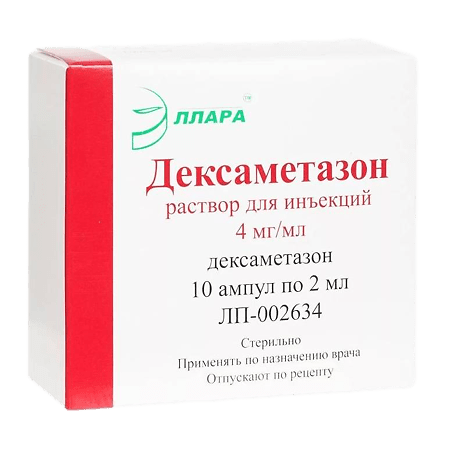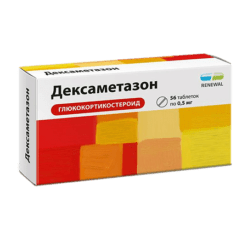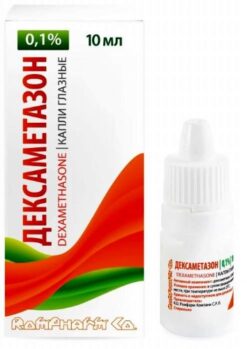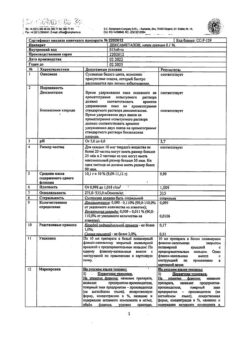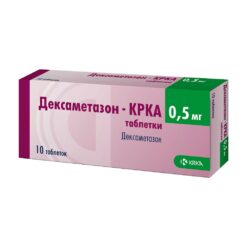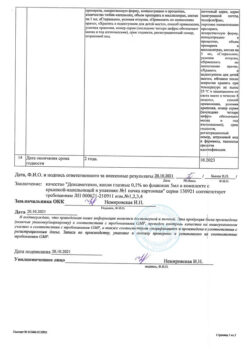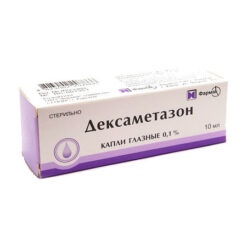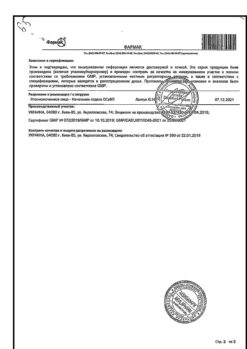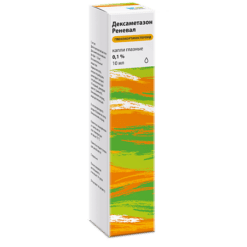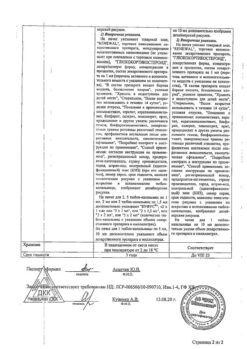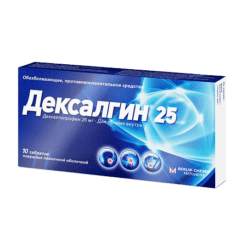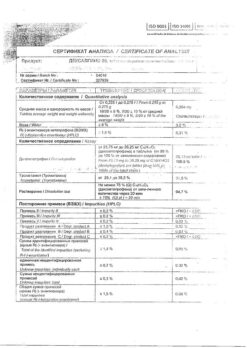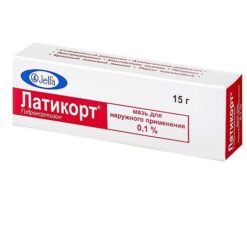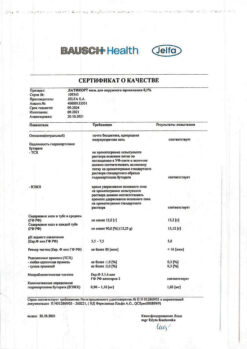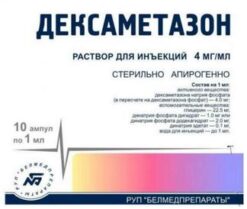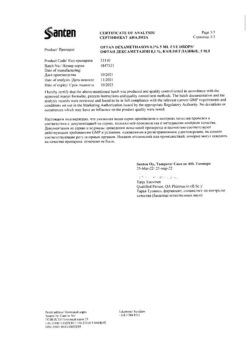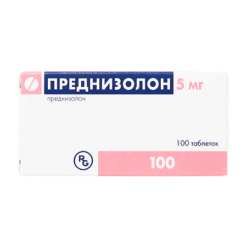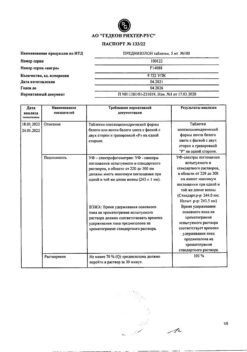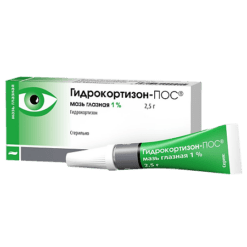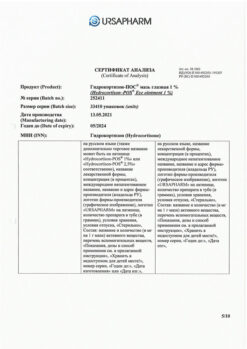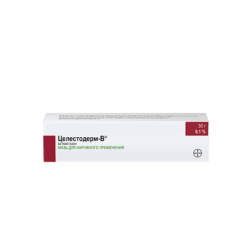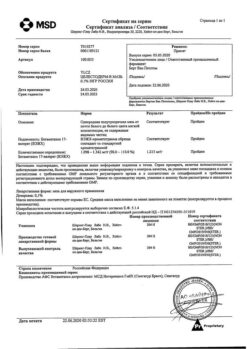No products in the cart.
Dexamethasone, 4 mg/ml 2 ml 10 pcs
€4.12 €3.67
Description
Pharmacotherapeutic group: glucocorticosteroid
ATX code: H02AB02
Pharmacological properties
Indications
Indications
Replacement therapy for adrenal insufficiency (in combination with sodium chloride and/or mineralocorticosteroids): acute adrenal insufficiency (Addison’s disease, bilateral adrenalectomy); relative insufficiency of the adrenal cortex, developing after discontinuation of treatment with corticosteroids; primary or secondary adrenal insufficiency.
Symptomatic and pathogenetic therapy of other diseases requiring the administration of fast-acting corticosteroids, as well as in cases where oral administration of the drug is impossible:
– endocrine diseases (congenital adrenal hyperplasia, subacute thyroiditis);
– shock (burn, traumatic, surgical, toxic) – in case of ineffectiveness of vasoconstrictors, plasma replacement drugs and other symptomatic therapy;
– cerebral edema (only after confirmation of symptoms of increased intracranial pressure by magnetic resonance or computed tomography results) caused by a brain tumor due to traumatic brain injury, neurosurgical intervention, cerebral hemorrhage, encephalitis, meningitis, radiation injury;
– asthmatic status; severe bronchospasm (exacerbation of bronchial asthma);
– severe allergic reactions, anaphylactic shock;
– rheumatic diseases;
– systemic connective tissue diseases;
– acute severe dermatoses;
– malignant diseases (palliative treatment of leukemia and lymphoma in adult patients; acute leukemia in children; hypercalcemia in patients with malignant tumors, when oral treatment is not possible);
– blood diseases (acute hemolytic anemia, agranulocytosis, idiopathic thrombocytopenic purpura in adults);
– in ophthalmological practice (subconjunctival, retrobulbar or parabulbar administration): keratitis, keratoconjunctivitis without damage to the epithelium, iritis, iridocyclitis, blepharitis, blepharoconjunctivitis, scleritis, episcleritis, inflammatory process after eye injuries and surgical interventions, sympathetic ophthalmia, immunosuppressive treatment after transplantation cornea;
– local application (in the area of pathological formation): keloids, discoid lupus erythematosus, granuloma annulare;
– poisoning with cauterizing liquids (reducing inflammation and preventing cicatricial contractions).
Pharmacological effect
Pharmacological effect
Pharmacotherapeutic group: glucocorticosteroid
ATX code: Н02АВ02
Pharmacological properties
Special instructions
Special instructions
During treatment with dexamethasone (especially long-term), observation by an ophthalmologist, monitoring of blood pressure and water-electrolyte balance, as well as peripheral blood patterns and blood glucose levels are necessary.
In order to reduce side effects, the intake of K+ into the body should be increased (diet, potassium supplements). Food should be rich in proteins, vitamins, and limit the content of fats, carbohydrates and table salt.
The effect of the drug is enhanced in patients with liver cirrhosis. It must be taken into account that in patients with hypothyroidism the clearance of dexamethasone is reduced, and in patients with thyrotoxicosis it is increased.
The drug may worsen existing emotional instability or psychotic disorders. If a history of psychosis is indicated, dexamethasone in high doses is prescribed under the strict supervision of a physician.
It should be used with caution in acute and subacute myocardial infarction – the necrosis may spread, the formation of scar tissue may slow down, and the heart muscle may rupture.
The patient should be carefully monitored for a year after the end of long-term dexamethasone therapy due to the possible development of relative adrenal insufficiency in stressful situations.
Long-term use of high doses of the drug requires a gradual dose reduction in order to prevent the development of acute adrenal insufficiency.
When using dexamethasone, there is a risk of developing severe anaphylactic reactions and bradycardia.
During drug therapy, the risk of activation of strongyloidiasis increases.
The dose of dexamethasone must be temporarily increased in stressful situations during therapy (surgery, trauma). A temporary increase in the dose of the drug in stressful situations is necessary both before and after stress.
During treatment with dexamethasone, it is necessary to use specific antibacterial therapy in the treatment of latent tuberculosis, lymphadenitis after BCG vaccination, polio, acute and chronic bacterial and parasitic infections and specific therapy in patients with gastric and intestinal ulcers, osteoporosis.
During drug therapy, careful monitoring of the condition of patients with chronic heart failure, uncontrolled arterial hypertension, trauma and ulcerative lesions of the cornea, and glaucoma is necessary.
Myasthenia gravis may worsen.
If the drug is suddenly discontinued, especially in the case of previous use of high doses, acute adrenal insufficiency may develop; withdrawal syndrome (not caused by adrenal insufficiency): loss of appetite, nausea, vomiting; lethargy, headache, generalized musculoskeletal pain, asthenia; as well as exacerbation of the disease for which dexamethasone was prescribed.
In patients with diabetes mellitus, blood glucose concentrations should be monitored and, if necessary, the dose of hypoglycemic drugs should be adjusted.
Dexamethasone may increase susceptibility to or mask symptoms of infectious diseases. Chickenpox, measles and other infections can be more severe and even fatal in unimmunized individuals. Immunosuppression most often develops with long-term use, but can also occur with short-term treatment with dexamethasone.
Taking the drug may mask the symptoms of “peritoneal irritation” in patients with perforation of the stomach or intestinal wall.
With the use of GCS, changes in sperm motility and number are possible.
Children who during the treatment period were in contact with patients with measles or chickenpox are prescribed specific immunoglobulins prophylactically. In children during long-term treatment with dexamethasone, careful monitoring of the dynamics of growth and development is necessary.
Impact on the ability to drive vehicles and machinery
During treatment, it is not recommended to drive vehicles, as well as engage in potentially hazardous activities that require rapid psychomotor reactions and increased concentration.
Active ingredient
Active ingredient
Dexamethasone
Composition
Composition
Per 1 ml:
Active substance:
dexamethasone sodium phosphate (in terms of dexamethasone phosphate) -4.0 mg.
Excipients: glycerol (distilled glycerin PK-94) – 22.5 mg, sodium hydrogen phosphate dodecahydrate (sodium phosphate disubstituted 12-water) -0.8 mg; disodium edetate dihydrate [(disodium salt ethylenediamine-N, N, N’, N’ – tetraacetic acid 2-water (trilon B)] – 0.1 mg; water for injection – up to 1 ml.
Pregnancy
Pregnancy
Dexamethasone crosses the placenta and can reach high concentrations in the fetus. During pregnancy (especially in the first trimester) or in women planning a pregnancy, taking Dexamethasone is indicated if the expected therapeutic effect of the drug exceeds the risk of negative effects on the mother or fetus. GCS should be prescribed during pregnancy only for absolute indications. With long-term therapy during pregnancy, the possibility of impaired fetal growth cannot be excluded. If used at the end of pregnancy, there is a risk of atrophy of the adrenal cortex in the fetus, which may require replacement therapy in the newborn.
A small amount of dexamethasone passes into breast milk.
If it is necessary to carry out treatment with the drug during breastfeeding, breastfeeding should be discontinued, as this may lead to retardation of the child’s growth and a decrease in the secretion of his endogenous corticosteroids.
Contraindications
Contraindications
For short-term use for “life-saving” indications, the only contraindication is hypersensitivity to any of the components of the drug. Breastfeeding period, systemic mycoses.
Concomitant use of live or attenuated vaccines with immunosuppressive doses of Dexamethasone.
With caution
Systemic parasitic and infectious diseases of a viral, fungal or bacterial nature (currently or recently suffered, including recent contact with a patient) – herpes simplex, herpes zoster (viremic phase), chicken pox, measles; amebiasis, strongyloidiasis (established or suspected); active or latent tuberculosis. Use for severe infectious diseases is permissible only against the background of specific antimicrobial therapy.
Vaccination period (8 weeks before and 2 weeks after vaccination), lymphadenitis after BCG vaccination. Immunodeficiency conditions (including AIDS or HIV infection).
Gastrointestinal diseases: peptic ulcer of the stomach and duodenum, esophagitis, gastritis, acute or latent peptic ulcer, recently created intestinal anastomosis, ulcerative colitis with the threat of perforation or abscess formation, diverticulitis.
Liver failure.
Hypoalbuminemia and conditions predisposing to its occurrence.
Diseases of the cardiovascular system, including recent myocardial infarction, decompensated chronic heart failure, arterial hypertension, hyperlipidemia.
Endocrine diseases – diabetes mellitus (including impaired carbohydrate tolerance), thyrotoxicosis, hypothyroidism, Itsenko-Cushing’s disease, stage III-IV obesity.
Severe chronic renal failure, nephrourolithiasis.
Systemic osteoporosis, myasthenia gravis, poliomyelitis (except for the form of bulbar encephalitis), epilepsy, “steroid” myopathy.
Acute psychosis, severe affective disorders (including a history of, especially “steroid” psychosis).
Open- and closed-angle glaucoma, eye herpes (risk of corneal perforation).
Pregnancy.
Elderly patients – due to the high risk of developing osteoporosis and arterial hypertension.
In children during the growth period, dexamethasone should be used only for absolute indications and under the careful supervision of the attending physician.
Side Effects
Side Effects
The incidence and severity of side effects depend on the duration of use, the size of the dose used and the ability to comply with the circadian rhythm of the prescription.
Endocrine system disorders: decreased glucose tolerance, “steroidal” diabetes mellitus or manifestation of latent diabetes mellitus, suppressed adrenal function, Itsenko-Cushing syndrome (moon-shaped face, pituitary-type obesity, hirsutism, increased blood pressure, dysmenorrhea, amenorrhea, myasthenia, “steroidal” stretch marks), delayed sexual development in children.
Blood and lymphatic system disorders: moderate leukocytosis, lymphopenia, eosinopenia, polycythemia.
Gastrointestinal tract disorders: nausea, vomiting, pancreatitis, “steroid” gastric and duodenal ulcers, erosive esophagitis, bleeding and perforation of the stomach or intestines, increased or decreased appetite, flatulence, hiccups, abdominal pain, discomfort in the stomach. In rare cases, increased activity of liver transaminases and alkaline phosphatase.
Disorders of the heart and blood vessels: arrhythmias, bradycardia (up to cardiac arrest); development (in predisposed patients) or worsening of chronic heart failure; electrocardiogram changes characteristic of hypokalemia; increased blood pressure, hypercoagulation, thrombosis; with intravenous administration: “hot flashes” to the face, vasculitis, increased capillary fragility. In patients with acute and subacute myocardial infarction – the spread of necrosis, slowing down the formation of scar tissue, which can lead to rupture of the heart muscle.
Mental disorders: nervousness or anxiety, insomnia, emotional lability, delirium, disorientation, euphoria, hallucinations, manic-depressive psychosis, depression, paranoia, suicidal tendencies.
Nervous system disorders: increased intracranial pressure, dizziness, headache, vertigo, cerebellar pseudotumor, convulsions.
Violations of the organ of vision: sudden loss of vision (with parenteral administration in the head, neck, nasal turbinates, scalp, deposition of drug crystals in the vessels of the eye is possible), posterior subcapsular cataract, increased intraocular pressure with possible damage to the optic nerve, a tendency to develop secondary bacterial, fungal or viral infections of the eyes, trophic changes in the cornea, exophthalmos, chemosis, ptosis, mydriasis, corneal perforation, central serous chorioretinopathy.
Metabolic and nutritional disorders: hypercholesterolemia, increased calcium excretion, hypocalcemia, weight gain, negative nitrogen balance (increased protein breakdown), increased sweating, epidural lipomatosis.
Caused by mineralocorticoid activity – fluid and sodium retention (peripheral edema), hypernatremia, hypokalemic syndrome (hypokalemia, arrhythmia, myalgia or muscle spasm, unusual weakness and fatigue).
Disorders of the musculoskeletal and connective tissue: slower growth and ossification processes in children (premature closure of the epiphyseal growth zones), osteoporosis (very rarely – pathological bone fractures, aseptic necrosis of the head of the humerus and femur), rupture of muscle tendons, “steroid” myopathy, decreased muscle mass (atrophy).
Renal and urinary tract disorders: leukocyturia.
Disorders of the skin and subcutaneous tissues: delayed wound healing, petechiae, ecchymoses, thinning of the skin, hyper- or hypopigmentation, “steroid” acne, “steroid” striae, a tendency to develop pyoderma and candidiasis, rosacea-like perioral dermatitis, suppressed reactions during skin tests, telangiectasia, hypertrichosis.
Immune system disorders: generalized (skin rash, skin itching, anaphylactic shock), local allergic reactions.
Infectious and parasitic diseases: development or exacerbation of infections (the appearance of this side effect is facilitated by jointly used immunosuppressants and vaccination).
General disorders and disorders at the injection site: withdrawal syndrome, local with parenteral administration: burning, numbness, pain, paresthesia and infection at the injection site, rarely – necrosis of surrounding tissues, scarring at the injection site; atrophy of the skin and subcutaneous tissue with intramuscular injection (injection into the deltoid muscle is especially dangerous).
Interaction
Interaction
Dexamethasone is pharmaceutically incompatible with other drugs (may form insoluble compounds). It is recommended to administer it separately from other drugs (iv bolus, or through another dropper, as a second solution). When mixing a solution of dexamethasone with heparin, a precipitate forms.
Dexamethasone increases the toxicity of cardiac glycosides (due to the resulting hypokalemia, the risk of developing arrhythmias increases).
Accelerates the elimination of acetylsalicylic acid, reduces the content of its metabolites in the blood (when dexamethasone is discontinued, the concentration of salicylates in the blood increases and the risk of side effects increases).
When used simultaneously with live antiviral vaccines and against the background of other types of immunizations, it increases the risk of viral activation and the development of infections.
Increases the metabolism of isoniazid, mexiletine (especially in “fast acetylators”), which leads to a decrease in their concentrations in the blood plasma.
Increases the risk of developing hepatotoxic effects of paracetamol (induction of liver enzymes and the formation of a toxic metabolite of paracetamol).
Increases (with long-term therapy) the content of folic acid.
Hypokalemia caused by dexamethasone may increase the severity and duration of muscle blockade due to muscle relaxants.
In high doses, it reduces the effect of somatropin.
Dexamethasone reduces the effect of hypoglycemic drugs; enhances the anticoagulant effect of coumarin derivatives.
Weakens the effect of vitamin D on calcium absorption in the intestinal lumen. Ergocalciferol and parathyroid hormone prevent the development of osteopathy caused by dexamethasone.
Reduces the concentration of praziquantel in the blood.
Cyclosporine (inhibits metabolism) and ketoconazole (reduces clearance) increase toxicity.
Thiazide diuretics, carbonic anhydrase inhibitors, other corticosteroids and amphotericin B increase the risk of hypokalemia, Na-containing drugs – edema and increased blood pressure.
Nonsteroidal anti-inflammatory drugs (NSAIDs) and ethanol increase the risk of developing ulceration of the gastrointestinal mucosa and bleeding; in combination with NSAIDs for the treatment of arthritis, it is possible to reduce the dose of GCS due to the summation of the therapeutic effect.
Indomethacin, displacing dexamethasone from its association with albumin, increases the risk of developing its side effects.
Amphotericin B and carbonic anhydrase inhibitors increase the risk of osteoporosis. The therapeutic effect of dexamethasone is reduced under the influence of phenytoin, barbiturates, ephedrine, theophylline, rifampicin and other inducers of microsomal liver enzymes (increased metabolic rate). Mitotane and other inhibitors of adrenal function may necessitate an increase in the dose of dexamethasone.
Dexamethasone clearance increases with the use of thyroid hormone medications.
Immunosuppressants increase the risk of developing infections and lymphoma or other lymphoproliferative disorders caused by the Epstein-Barr virus.
Estrogens (including oral estrogen-containing contraceptives) reduce the clearance of dexamethasone, prolong the half-life and their therapeutic and toxic effects.
The appearance of hirsutism and acne is facilitated by the simultaneous use of other steroid hormonal drugs – androgens, estrogens, anabolic steroids, oral contraceptives.
Tricyclic antidepressants may increase the severity of depression caused by taking dexamethasone (not indicated for the treatment of these side effects).
The risk of developing cataracts increases when used in conjunction with other corticosteroids, antipsychotic drugs (neuroleptics), carbutamide and azathioprine. Simultaneous administration with m-anticholinergics (including antihistamines, tricyclic antidepressants), nitrates contributes to the development of increased intraocular pressure.
When used simultaneously with fluoroquinolones, the risk of tendonopathy (mainly Achilles tendon) increases in elderly patients and in patients with tendon diseases.
Antimalarials (chloroquine, hydroxychloroquine, mefloquine) in combination with dexamethasone may increase the risk of developing myopathy and cardiomyopathy.
Angiotensin-converting enzyme inhibitors, when administered concomitantly with dexamethasone, can change the composition of peripheral blood.
Overdose
Overdose
Symptoms: increased blood pressure, peripheral edema, peptic ulcer, hyperglycemia, impaired consciousness.
Treatment: symptomatic, there is no specific antidote.
Storage conditions
Storage conditions
In a place protected from light at a temperature not exceeding 25 °C.
Keep out of the reach of children.
Shelf life
Shelf life
2 years. Do not use the drug after the expiration date indicated on the package.
Manufacturer
Manufacturer
Ellara LLC, Russia
Additional information
| Shelf life | 2 years. Do not use the drug after the expiration date stated on the package. |
|---|---|
| Conditions of storage | In the dark place at a temperature not exceeding 25 °C. Keep out of reach of children. |
| Manufacturer | Ellara, Russia |
| Medication form | solution for injection |
| Brand | Ellara |
Other forms…
Related products
Buy Dexamethasone, 4 mg/ml 2 ml 10 pcs with delivery to USA, UK, Europe and over 120 other countries.

